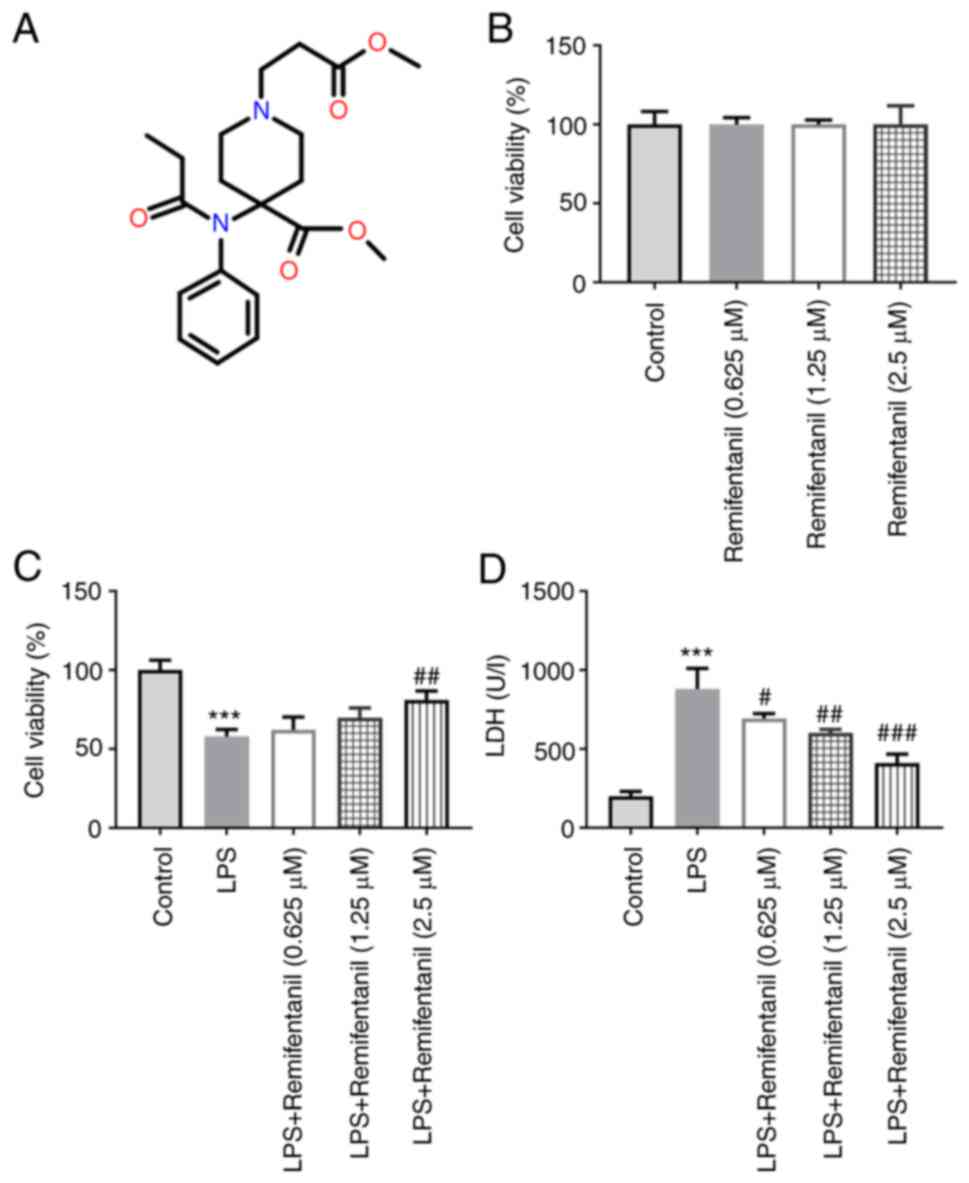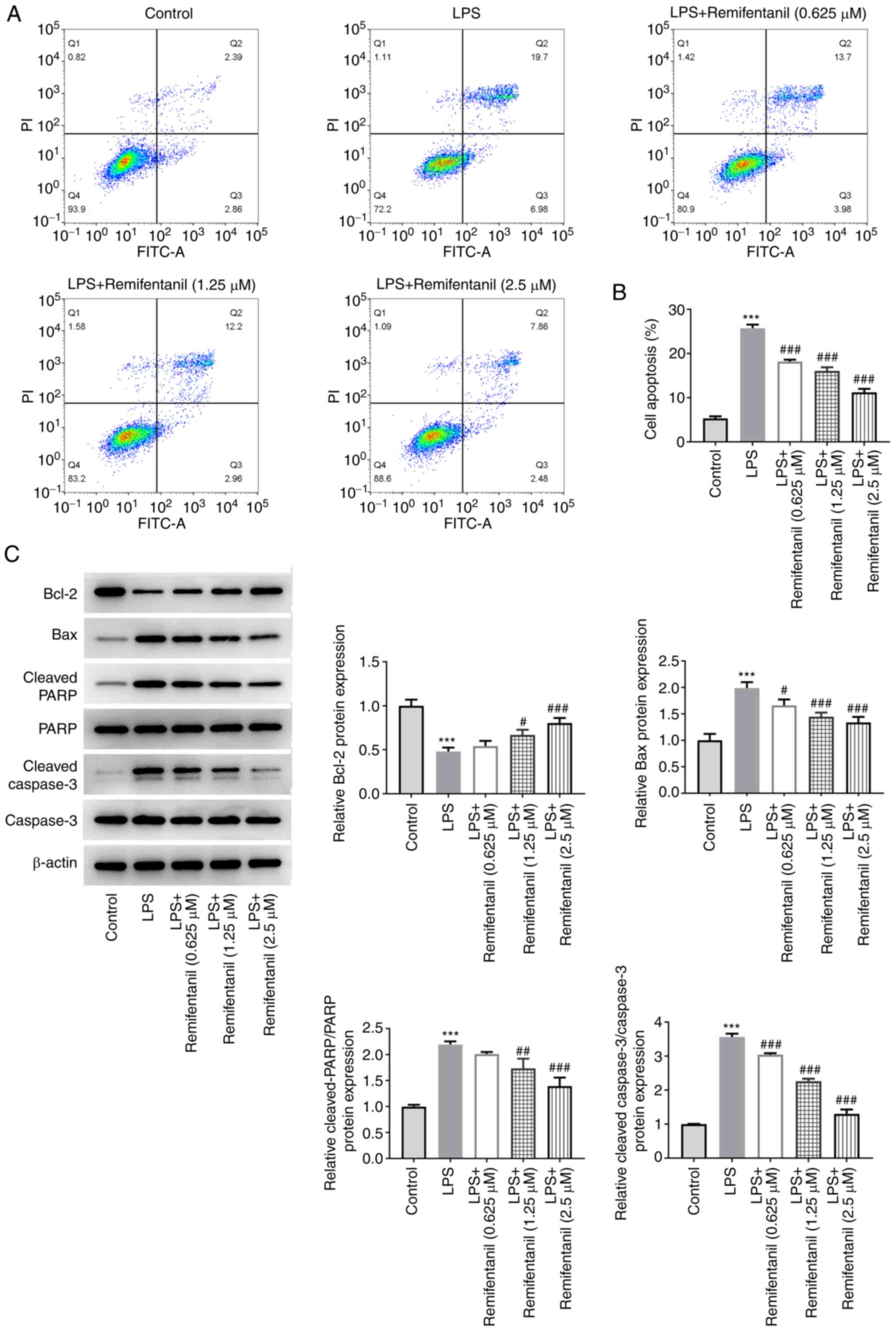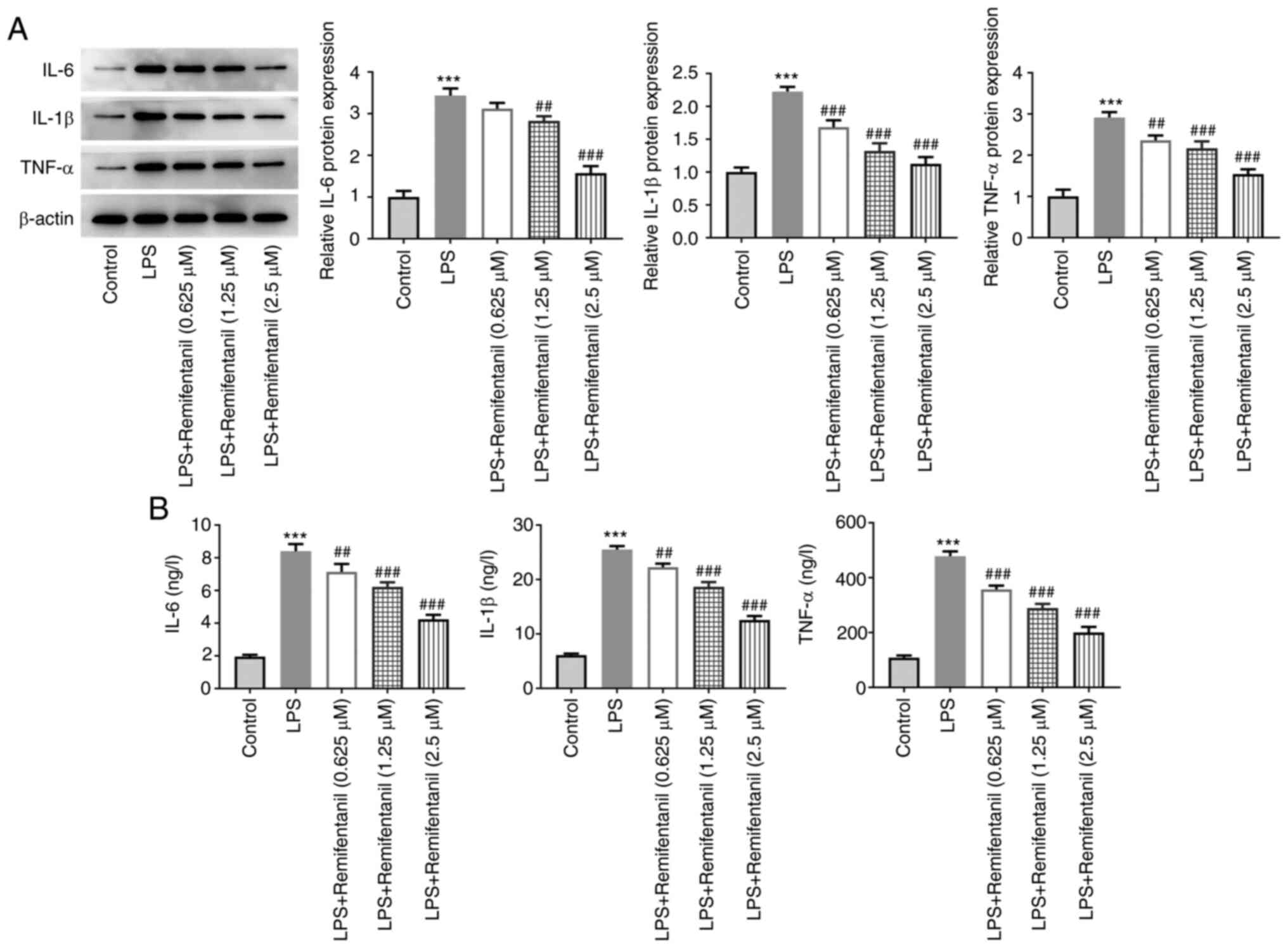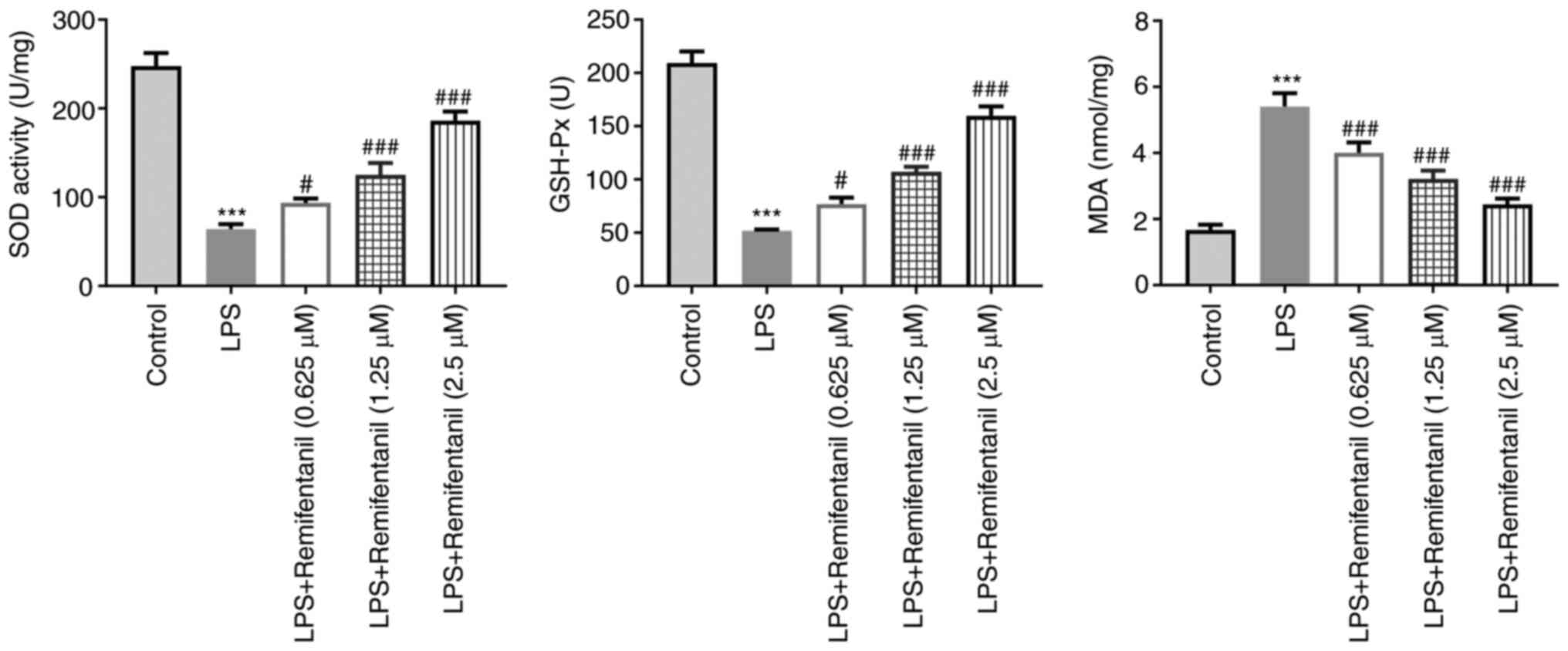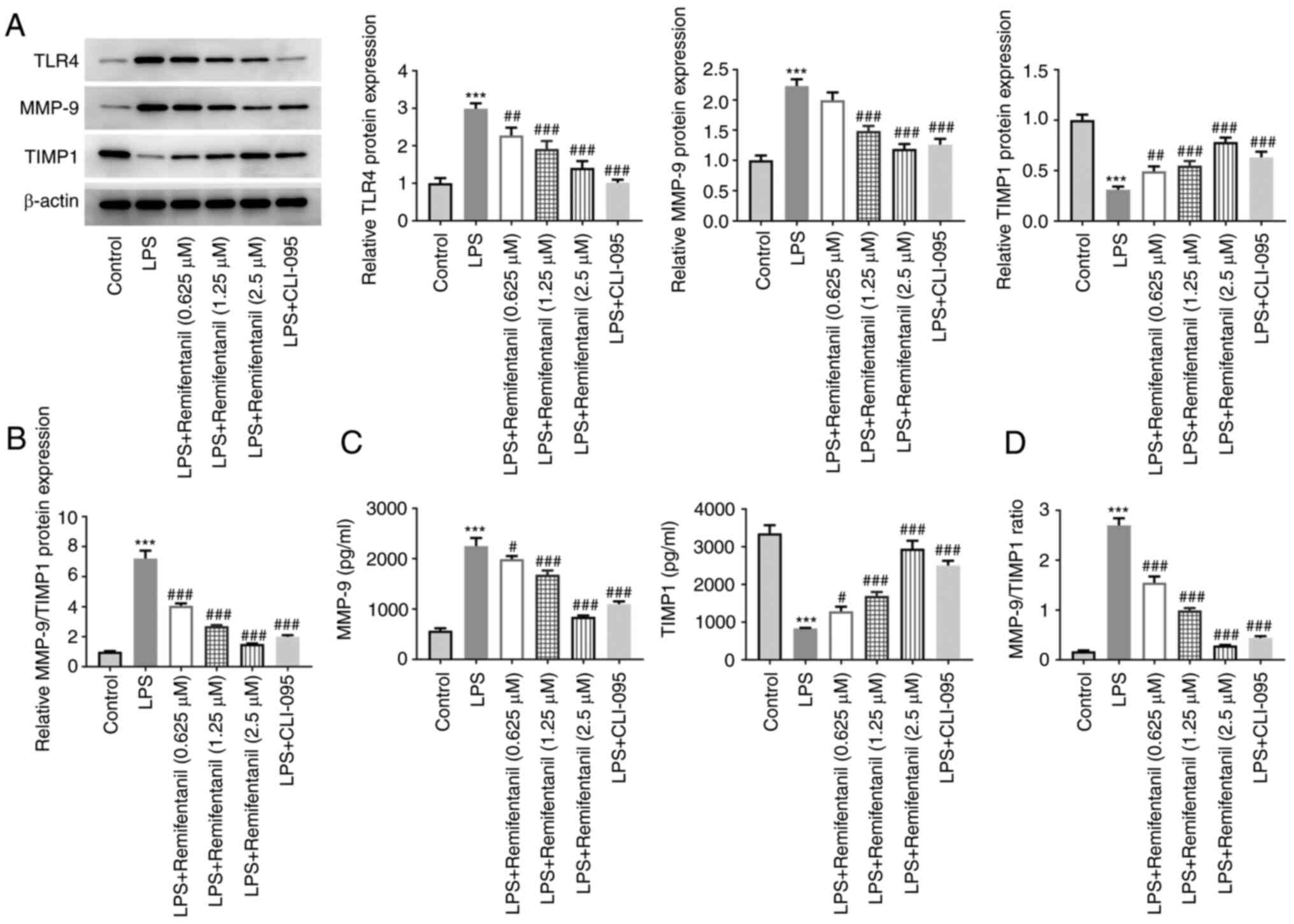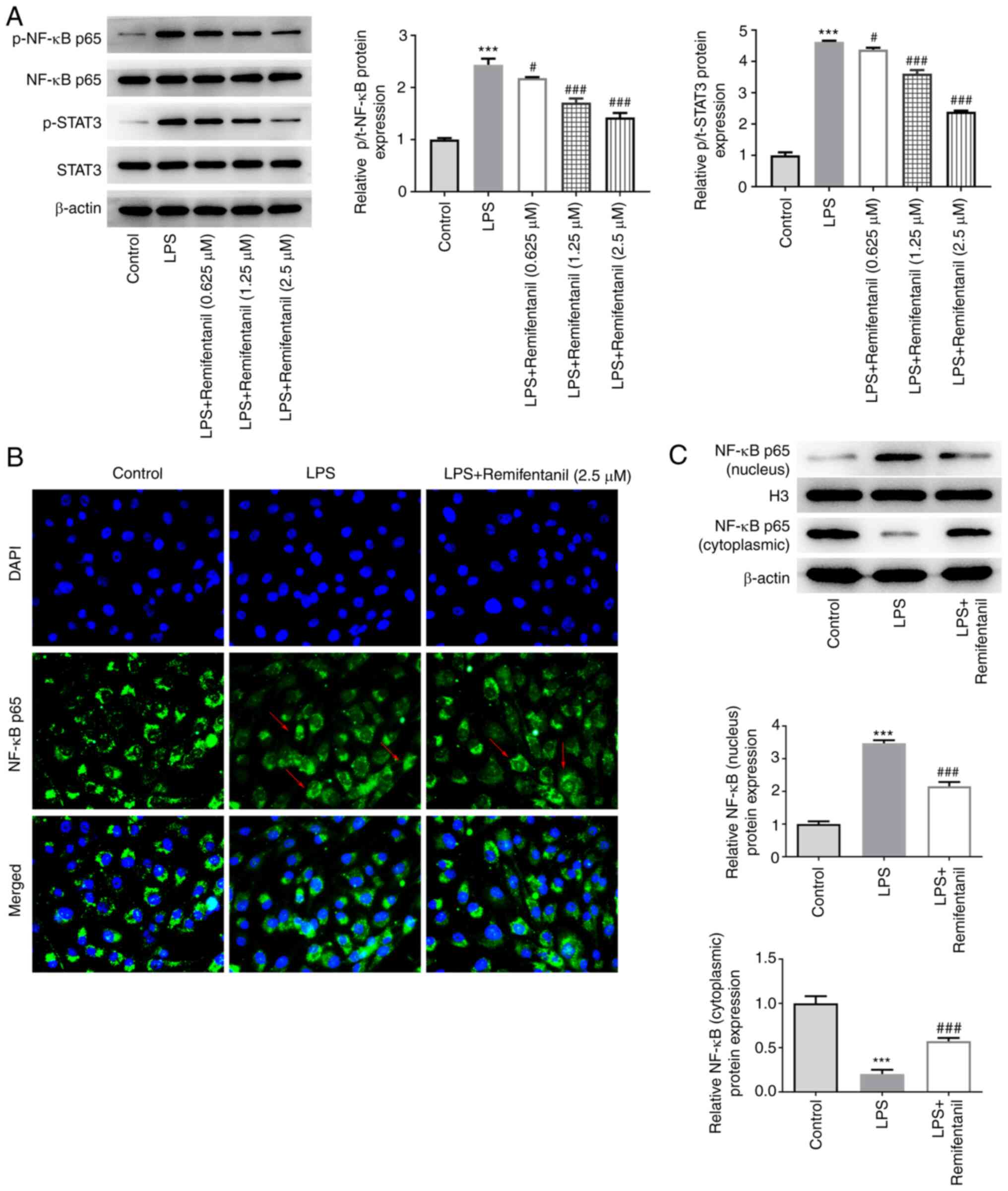|
1
|
Swenson KE and Swenson ER: Pathophysiology
of acute respiratory distress syndrome and COVID-19 lung injury.
Crit Care Clin. 37:749–776. 2021.PubMed/NCBI View Article : Google Scholar
|
|
2
|
Zhou Y, Li P, Goodwin AJ, Cook JA,
Halushka PV, Chang E, Zingarelli B and Fan H: Exosomes from
endothelial progenitor cells improve outcomes of the
lipopolysaccharide-induced acute lung injury. Crit Care.
23(44)2019.PubMed/NCBI View Article : Google Scholar
|
|
3
|
Li J, Lu K, Sun F, Tan S, Zhang X, Sheng
W, Hao W, Liu M, Lv W and Han W: Panaxydol attenuates ferroptosis
against LPS-induced acute lung injury in mice by Keap1-Nrf2/HO-1
pathway. J Transl Med. 19(96)2021.PubMed/NCBI View Article : Google Scholar
|
|
4
|
Wang YM, Ji R, Chen WW, Huang SW, Zheng
YJ, Yang ZT, Qu HP, Chen H, Mao EQ, Chen Y and Chen EZ: Paclitaxel
alleviated sepsis-induced acute lung injury by activating MUC1 and
suppressing TLR-4/NF-κB pathway. Drug Des Devel Ther. 13:3391–3404.
2019.PubMed/NCBI View Article : Google Scholar
|
|
5
|
Cheng KT, Xiong S, Ye Z, Hong Z, Di A,
Tsang KM, Gao X, An S, Mittal M, Vogel SM, et al:
Caspase-11-mediated endothelial pyroptosis underlies
endotoxemia-induced lung injury. J Clin Invest. 127:4124–4135.
2017.PubMed/NCBI View
Article : Google Scholar
|
|
6
|
Tang J, Xu L, Zeng Y and Gong F: Effect of
gut microbiota on LPS-induced acute lung injury by regulating the
TLR4/NF-kB signaling pathway. Int Immunopharmacol.
91(107272)2021.PubMed/NCBI View Article : Google Scholar
|
|
7
|
McVey MJ, Steinberg BE and Goldenberg NM:
Inflammasome activation in acute lung injury. Am J Physiol Lung
Cell Mol Physiol. 320:L165–L178. 2021.PubMed/NCBI View Article : Google Scholar
|
|
8
|
Gouda MM and Bhandary YP: Acute lung
injury: IL-17A-mediated inflammatory pathway and its regulation by
curcumin. Inflammation. 42:1160–1169. 2019.PubMed/NCBI View Article : Google Scholar
|
|
9
|
Chen C, He Y, Feng Y, Hong W, Luo G and Ye
Z: . Long non-coding RNA review and implications in acute lung
inflammation. Life Sci. 269(119044)2021.PubMed/NCBI View Article : Google Scholar
|
|
10
|
Chen T, Wei Y, Zhu G, Zhao H and Zhang X:
Design, synthesis and structure-activity relationship studies of
4-indole-2-arylaminopyrimidine derivatives as anti-inflammatory
agents for acute lung injury. Eur J Med Chem.
225(113766)2021.PubMed/NCBI View Article : Google Scholar
|
|
11
|
Song W, Yang X, Wang W, Wang Z, Wu J and
Huang F: Sinomenine ameliorates septic acute lung injury in mice by
modulating gut homeostasis via aryl hydrocarbon receptor/Nrf2
pathway. Eur J Pharmacol. 912(174581)2021.PubMed/NCBI View Article : Google Scholar
|
|
12
|
Brochard L, Slutsky A and Pesenti A:
Mechanical ventilation to minimize progression of lung injury in
acute respiratory failure. Am J Respir Crit Care Med. 195:438–442.
2017.PubMed/NCBI View Article : Google Scholar
|
|
13
|
Beitler JR, Malhotra A and Thompson BT:
Ventilator-induced lung injury. Clin Chest Med. 37:633–646.
2016.PubMed/NCBI View Article : Google Scholar
|
|
14
|
Cappoli N, Aceto P, Tabolacci E, Mezzogori
D, Sollazzi L, Navarra P and Dello Russo C: Effects of remifentanil
on human C20 microglial pro-inflammatory activation. Eur Rev Med
Pharmacol Sci. 25:5268–5274. 2021.PubMed/NCBI View Article : Google Scholar
|
|
15
|
Nowoczyn M, Marie N, Coulbault L, Hervault
M, Davis A, Hanouz JL and Allouche S: Remifentanil produces
cross-desensitization and tolerance with morphine on the mu-opioid
receptor. Neuropharmacology. 73:368–379. 2013.PubMed/NCBI View Article : Google Scholar
|
|
16
|
Azzam AAH, McDonald J and Lambert DG: Hot
topics in opioid pharmacology: Mixed and biased opioids. Br J
Anaesth. 122:e136–e145. 2019.PubMed/NCBI View Article : Google Scholar
|
|
17
|
Grillot N, Garot M, Lasocki S, Huet O,
Bouzat P, Le Moal C, Oudot M, Chatel-Josse N, El Amine Y, Danguy
des Déserts M, et al: Assessment of remifentanil for rapid sequence
induction and intubation in patients at risk of pulmonary
aspiration of gastric contents compared to rapid-onset paralytic
agents: Study protocol for a non-inferiority simple blind
randomized controlled trial (the REMICRUSH study). Trials.
22(237)2021.PubMed/NCBI View Article : Google Scholar
|
|
18
|
Kato M, Satoh D, Okada Y, Sugiyama K, Toda
N and Kurosawa S: Pharmacodynamics and pharmacokinetics of
remifentanil: Overview and comparison with other opioids. Masui.
56:1281–1286. 2007.PubMed/NCBI(In Japanese).
|
|
19
|
Bevans T, Deering-Rice C, Stockmann C,
Light A, Reilly C and Sakata DJ: Inhaled remifentanil in rodents.
Anesth Analg. 122:1831–1838. 2016.PubMed/NCBI View Article : Google Scholar
|
|
20
|
Grape S, Kirkham KR, Frauenknecht J and
Albrecht E: Intra-operative analgesia with remifentanil vs
dexmedetomidine: A systematic review and meta-analysis with trial
sequential analysis. Anaesthesia. 74:793–800. 2019.PubMed/NCBI View Article : Google Scholar
|
|
21
|
Ni XQ and Hu ZY: Remifentanil improves
myocardial ischemia-reperfusion injury in rats through inhibiting
IL-18 signaling pathway. Eur Rev Med Pharmacol Sci. 24:3915–3922.
2020.PubMed/NCBI View Article : Google Scholar
|
|
22
|
Cao D, Liu S, Yang M, Xie K, Zheng Z, Wen
H and Xie X: Remifentanil preconditioning alleviates myocardial
ischemia/reperfusion injury in rats via activating Jagged-1/Notch
signaling pathway. Biosci Rep: BSR20210534, 2021 (Epub ahead of
print).
|
|
23
|
Zhang JN, Ma Y, Wei XY, Liu KY, Wang H,
Han H, Cui Y, Zhang MX and Qin WD: Remifentanil protects against
lipopolysaccharide-induced inflammation through PARP-1/NF-κB
signaling pathway. Mediators Inflamm. 2019(3013716)2019.PubMed/NCBI View Article : Google Scholar
|
|
24
|
Seo KH, Choi JW, Jung HS, Yoo H and Joo
JD: The effects of remifentanil on expression of high mobility
group box 1 in septic rats. J Korean Med Sci. 32:542–551.
2017.PubMed/NCBI View Article : Google Scholar
|
|
25
|
Tall AR and Yvan-Charvet L: Cholesterol,
inflammation and innate immunity. Nat Rev Immunol. 15:104–116.
2015.PubMed/NCBI View
Article : Google Scholar
|
|
26
|
Chung FT, Huang HY, Lo CY, Huang YC, Lin
CW, He CC, He JR, Sheng TF and Wang CH: Increased ratio of matrix
metalloproteinase-9 (MMP-9)/tissue inhibitor metalloproteinase-1
from alveolar macrophages in chronic asthma with a fast decline in
FEV(1) at 5-year follow-up. J Clin Med. 8(1451)2019.PubMed/NCBI View Article : Google Scholar
|
|
27
|
Zhang Y, Liu H, Chen Z, Yu M, Li J, Dong
H, Li N, Ding X, Ge Y, Liu C, et al: TLR4-mediated hippocampal
MMP/TIMP imbalance contributes to the aggravation of perioperative
neurocognitive disorder in db/db mice. Neurochem Int.
140(104818)2020.PubMed/NCBI View Article : Google Scholar
|
|
28
|
Zhang C, Zhu X, Hua Y, Zhao Q, Wang K,
Zhen L, Wang G, Lü J, Luo A, Cho WC, et al: YY1 mediates
TGF-β1-induced EMT and pro-fibrogenesis in alveolar epithelial
cells. Respir Res. 20(249)2019.PubMed/NCBI View Article : Google Scholar
|
|
29
|
Foster KA, Oster CG, Mayer MM, Avery ML
and Audus KL: Characterization of the A549 cell line as a type II
pulmonary epithelial cell model for drug metabolism. Exp Cell Res.
243:359–366. 1998.PubMed/NCBI View Article : Google Scholar
|
|
30
|
Lei S, Zhang Y, Su W, Zhou L, Xu J and Xia
ZY: Remifentanil attenuates lipopolysaccharide-induced oxidative
injury by downregulating PKCβ2 activation and inhibiting autophagy
in H9C2 cardiomyocytes. Life Sci. 213:109–115. 2018.PubMed/NCBI View Article : Google Scholar
|
|
31
|
Xu B, Wang H and Chen Z: Puerarin inhibits
ferroptosis and inflammation of lung injury caused by sepsis in LPS
induced lung epithelial cells. Front Pediatr.
9(706327)2021.PubMed/NCBI View Article : Google Scholar
|
|
32
|
Zhang M, Xue Y, Chen H, Meng L, Chen B,
Gong H, Zhao Y and Qi R: Resveratrol inhibits MMP3 and MMP9
expression and secretion by suppressing TLR4/NF-κB/STAT3 activation
in Ox-LDL-treated HUVECs. Oxid Med Cell Longev.
2019(9013169)2019.PubMed/NCBI View Article : Google Scholar
|
|
33
|
Abedi F, Hayes AW, Reiter R and Karimi G:
Acute lung injury: The therapeutic role of Rho kinase inhibitors.
Pharmacol Res. 155(104736)2020.PubMed/NCBI View Article : Google Scholar
|
|
34
|
White CW, Rancourt RC and Veress LA:
Sulfur mustard inhalation: Mechanisms of injury, alteration of
coagulation, and fibrinolytic therapy. Ann N Y Acad Sci.
1378:87–95. 2016.PubMed/NCBI View Article : Google Scholar
|
|
35
|
Yu Y, Jiang P, Sun P, Su N and Lin F:
Pulmonary coagulation and fibrinolysis abnormalities that favor
fibrin deposition in the lungs of mouse antibody-mediated
transfusion-related acute lung injury. Mol Med Rep.
24(601)2021.PubMed/NCBI View Article : Google Scholar
|
|
36
|
Gouda MM, Shaikh SB and Bhandary YP:
Inflammatory and fibrinolytic system in acute respiratory distress
syndrome. Lung. 196:609–616. 2018.PubMed/NCBI View Article : Google Scholar
|
|
37
|
Zhang HX, Liu SJ, Tang XL, Duan GL, Ni X,
Zhu XY, Liu YJ and Wang CN: H2S attenuates LPS-induced acute lung
injury by reducing oxidative/nitrative stress and inflammation.
Cell Physiol Biochem. 40:1603–1612. 2016.PubMed/NCBI View Article : Google Scholar
|
|
38
|
Gao M, Yu T, Liu D, Shi Y, Yang P, Zhang
J, Wang J, Liu Y and Zhang X: Sepsis plasma-derived exosomal
miR-1-3p induces endothelial cell dysfunction by targeting SERP1.
Clin Sci (Lond). 135:347–365. 2021.PubMed/NCBI View Article : Google Scholar
|
|
39
|
Ojima M, Yamamoto N, Hirose T, Hamaguchi
S, Tasaki O, Kojima T, Tomono K, Ogura H and Shimazu T: Serial
change of neutrophil extracellular traps in tracheal aspirate of
patients with acute respiratory distress syndrome: Report of three
cases. J Intensive Care. 8(25)2020.PubMed/NCBI View Article : Google Scholar
|
|
40
|
Liu Y, Yang Y, Zhang C, Huang F, Wang F,
Yuan J, Wang Z, Li J, Li J, Feng C, et al: Clinical and biochemical
indexes from 2019-nCoV infected patients linked to viral loads and
lung injury. Sci China Life Sci. 63:364–374. 2020.PubMed/NCBI View Article : Google Scholar
|
|
41
|
Yang Y, Chen C, Cui C, Jiao Y, Li P, Zhu
L, Yu W, Xia Q, Wen D and Yang L: Indispensable role of β-arrestin2
in the protection of remifentanil preconditioning against hepatic
ischemic reperfusion injury. Sci Rep. 9(2087)2019.PubMed/NCBI View Article : Google Scholar
|
|
42
|
Tao Z, Jie Y, Mingru Z, Changping G, Fan
Y, Haifeng W and Yuelan W: The Elk1/MMP-9 axis regulates E-cadherin
and occludin in ventilator-induced lung injury. Respir Res.
22(233)2021.PubMed/NCBI View Article : Google Scholar
|
|
43
|
Liang Y, Yang N, Pan G, Jin B, Wang S and
Ji W: Elevated IL-33 promotes expression of MMP2 and MMP9 via
activating STAT3 in alveolar macrophages during LPS-induced acute
lung injury. Cell Mol Biol Lett. 23(52)2018.PubMed/NCBI View Article : Google Scholar
|
|
44
|
Corbel M, Boichot E and Lagente V: Role of
gelatinases MMP-2 and MMP-9 in tissue remodeling following acute
lung injury. Braz J Med Biol Res. 33:749–754. 2000.PubMed/NCBI View Article : Google Scholar
|
|
45
|
Chen G, Ge D, Zhu B, Shi H and Ma Q:
Upregulation of matrix metalloproteinase 9 (MMP9)/tissue inhibitor
of metalloproteinase 1 (TIMP1) and MMP2/TIMP2 ratios may be
involved in lipopolysaccharide-induced acute lung injury. J Int Med
Res. 48(300060520919592)2020.PubMed/NCBI View Article : Google Scholar
|
|
46
|
Zhou Q, Song J, Wang Y and Lin T:
Remifentanil attenuates cardiac dysfunction, lipid peroxidation and
immune disorder in rats with isoproterenol-induced myocardial
injury via JNK/NF-KB p65 inhibition. Ann Transl Med.
8(551)2020.PubMed/NCBI View Article : Google Scholar
|
|
47
|
Min Y, Kim MJ, Lee S, Chun E and Lee KY:
Inhibition of TRAF6 ubiquitin-ligase activity by PRDX1 leads to
inhibition of NFKB activation and autophagy activation. Autophagy.
14:1347–1358. 2018.PubMed/NCBI View Article : Google Scholar
|
|
48
|
Bianco C, Thompson L and Mohr I:
Repression of eEF2K transcription by NF-κB tunes translation
elongation to inflammation and dsDNA-sensing. Proc Natl Acad Sci
USA. 116:22583–22590. 2019.PubMed/NCBI View Article : Google Scholar
|
|
49
|
Yang H, Lv H, Li H, Ci X and Peng L:
Oridonin protects LPS-induced acute lung injury by modulating
Nrf2-mediated oxidative stress and Nrf2-independent NLRP3 and NF-κB
pathways. Cell Commun Signal. 17(62)2019.PubMed/NCBI View Article : Google Scholar
|
|
50
|
Zhao J, Yu H, Liu Y, Gibson SA, Yan Z, Xu
X, Gaggar A, Li PK, Li C, Wei S, et al: Protective effect of
suppressing STAT3 activity in LPS-induced acute lung injury. Am J
Physiol Lung Cell Mol Physiol. 311:L868–L880. 2016.PubMed/NCBI View Article : Google Scholar
|
|
51
|
Dubový P, Hradilová-Svíženská I, Klusáková
I, Kokošová V, Brázda V and Joukal M: Bilateral activation of STAT3
by phosphorylation at the tyrosine-705 (Y705) and serine-727 (S727)
positions and its nuclear translocation in primary sensory neurons
following unilateral sciatic nerve injury. Histochem Cell Biol.
150:37–47. 2018.PubMed/NCBI View Article : Google Scholar
|
|
52
|
Peron M, Dinarello A, Meneghetti G,
Martorano L, Betto RM, Facchinello N, Tesoriere A, Tiso N, Martello
G and Argenton F: Y705 and S727 are required for the mitochondrial
import and transcriptional activities of STAT3, and for regulation
of stem cell proliferation. Development.
148(dev199477)2021.PubMed/NCBI View Article : Google Scholar
|
|
53
|
Hirano T: IL-6 in inflammation,
autoimmunity and cancer. Int Immunol. 33:127–148. 2021.PubMed/NCBI View Article : Google Scholar
|
|
54
|
Wang Y, Shen Y, Wang S, Shen Q and Zhou X:
The role of STAT3 in leading the crosstalk between human cancers
and the immune system. Cancer Lett. 415:117–128. 2018.PubMed/NCBI View Article : Google Scholar
|
|
55
|
Zou S, Tong Q, Liu B, Huang W, Tian Y and
Fu X: Targeting STAT3 in cancer immunotherapy. Mol Cancer.
19(145)2020.PubMed/NCBI View Article : Google Scholar
|
|
56
|
Fan Y, Mao R and Yang J: NF-κB and STAT3
signaling pathways collaboratively link inflammation to cancer.
Protein Cell. 4:176–185. 2013.PubMed/NCBI View Article : Google Scholar
|















